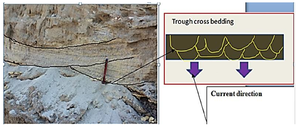Sandstone sedimentology and stratigraphy
| Wiki Write-Off Entry | |
|---|---|

| |
| Student Chapter | Makerere University Kampala |
| Competition | December 2014 |
Sandstone is a clastic sedimentary reservoir rock composed of mainly quartz and/or feldspars, and typically deposited by relatively high-energy processes, which winnow out much of the fine particle size fraction while transporting and depositing the coarser (sand-sized) particles. Like sand, sandstone may be any color, but the most common colors are tan, brown, yellow, red, grey, pink, white and black depending on the mineral composition. According to Dott's (1964) classification scheme, sandstones are classified into: quartz arenite, sublithic arenite, lithic arenite, arkosic arenite and arkose based on the mineralogy of framework grains, and arenites, wackes, and mudrocks based on the type of matrix present in between the framework grains. Arenites are the best known petroleum reservoir rock with good porosity and high permeability mainly dependent on reservoir fluid and rock properties; mainly influenced and modified by the depositional environment and burial history diagenetic processes. The depositional environments associated with sandstones are very important and they range from terrestrial to deep marine, including: Fluvial (alluvial fans, river sediments); Deltaic (levees, distributary deposits ,mouth bars and other sediments formed where river meets a lake or sea); Aeolian(wind-blown dune sands formed in coastal and desert environments); Shoreline ( beaches, barrier bars, tidal deltas and similar deposits formed in coastal areas);Glacial(sandy materials in tillites and other glacier deposits); and Deep-sea sediments, including contourite sands formed by ocean-bottom currents, turbidites and submarine fan deposits, formed by gravity-driven mass movements. Depositional conditions at any instant vary from one location to another which results in lateral as well as vertical changes within the reservoir and within individual rock units. These changes result in variations in porosity, fluid distribution, and permeability. However the main diagenetic process in sandstone such as compaction, cementation and dissolution also change these variations and affect the reservoir quality. Hence good analytical interpretations, research, innovativeness and learnt knowledge of sandstone composition, associated depositional environment and burial diagenetic history are vital for the success of any petroleum industry since over 60% of the world’s giant fields have sandstone reservoirs.
Sandstone is most significant type of petroleum reservoir rock in over 60% of the world’s giant fields; composed of mainly quartz and/or feldspars and typically deposited by relatively high- energy processes, which winnow out much of the fine particle size fraction while transporting and depositing the coarser (sand-sized) particles. Like sand, sandstone may be any color, but the most common colors are tan, brown, yellow, red, grey, pink, white and black. However, since sandstone beds often form highly visible cliffs and other topographic features, certain colors of sandstone have been strongly identified with certain regions depending on the for example red sandstone Red sandstone found in interior of Lower Antelope Canyon, Arizona.
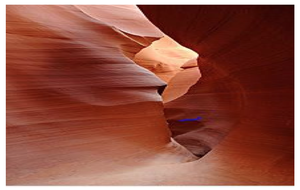
Composition of sandstone
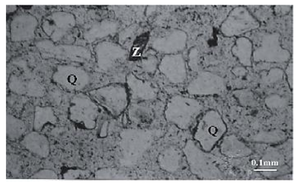
Sandstone also commonly known as arenite is a clastic sedimentary rock composed mainly of sand-sized minerals or rock grains of about 0.05mm to 2cm, matrix, cement and pore space (Figure 2).
- Rock grains. The grains that make up the bulk of sandstones can be classified into several different categories based on their mineral composition:
- Quartz grains: are the most dominate, moderately rounded, subhedral, have high degree of hardness, and are chemical stable which allows them to survive multiple recycling events.
- Feldspars: commonly alkali feldspars and plagioclase feldspars. Alkali feldspar consists of complete solid solution consisting group of minerals in which the chemical composition of the mineral can range from KAlSi3O8 to NaAlSi3O8 while Plagioclase feldspars are a complex group of solid solution minerals that range in composition from NaAlSi3O8 to CaAl2Si2O8.
- Lithic fragments: are pieces of ancient source rock that have yet to weather away to individual mineral grains. Lithic grains may be any fine-grained or coarse- grained igneous, metamorphic, or sedimentary rock. Although, the most commonly they are clasts of volcanic rocks.
- Accessory minerals make up a small percentage of the grains in a sandstone. They commonly include micas such as muscovite and biotite, olivine, pyroxene, and corundum, zircon, tourmaline, rutile, garnet, magnetite, or other dense, resistant minerals derived from the source rock.
- Matrix: is very fine material present within interstitial pore space between the rock grains. Sandstones are often classified on basis of amount of matrix into Arenites (quartz arenite, lithic arenite and feldspar arenite); which are texturally clean sandstones that are free of or have very little matrix, and Wackes are texturally dirty sandstones that have a significant amount of matrix.
- Cement: is a secondary mineral that forms after deposition and during burial of the sandstone and binds the siliclastic framework grains together. Cements mainly include carbonate, clay minerals and silica cements and Other minerals that act as cements include: hematite, limonite, feldspars, anhydrite, gypsum, barite, clay minerals, and zeolite . Silica cement can consist of either quartz or opal minerals. In sandstone where there is silica cement present the quartz grains are attached to cement, this creates a rim around the quartz grain called overgrowth. The overgrowth retains the same crystallographic continuity of quartz framework grain that is being cemented. However Opal cement often occurs in sandstones rich in volcanogenic materials, and very rarely is in other sandstones. Calcite cement is the most common carbonate cement. Calcite cement is an assortment of smaller calcite crystals. The cement adheres itself to the framework grains, this adhesion is what causes the framework grains to be adhered together.
- Pore space: consists of open spaces within the sandstone and has a direct relationship to the porosity and permeability of the rock. The porosity and permeability are directly influenced by the way the sand grains are packed together.
Sandstone classification
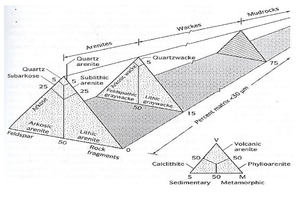
Sandstone classifications on basis of their composition and this can be typically done by use of a triangular quartz, feldspar, and lithic fragment diagrams. However, the most acceptable method is Dott's (1964) classification scheme which is based on the mineralogy of framework grains, and on the type of matrix present in between the framework grains.
Sandstone depositional environments
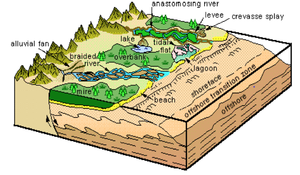
The depositional environments are very important and determine the reservoir quality. They sandstone beds range from terrestrial to deep marine, including: Fluvial (alluvial fans, river sediments); Deltaic (levees, distributary deposits ,mouth bars and other sediments formed where river meets a lake or sea); Aeolian(wind-blown dune sands formed in coastal and desert environments); Shoreline ( beaches, barrier bars, tidal deltas and similar deposits formed in coastal areas);Glacial(sandy materials in tillites and other glacier deposits); and Deep-sea sediments, including contourite sands formed by ocean-bottom currents, turbidites and submarine fan deposits, formed by gravity-driven mass movements.(Figure 4). However, Depositional conditions at any instant vary from one location to another which results in lateral as well as vertical changes within the reservoir and within individual rock units. These changes result in variations in porosity, fluid distribution, and permeability.
Fluvial sandstones
Fluvial or alluvial sandstones are not so well sorted sand deposits containing carbonaceous debris and clay trapped in the spaces within the framework grains. They are formed in river channel deposits and terrestrial environments, and are commonly developed on unconformity surfaces. Individual sands in meandering and braided stream deposits are as thick as the depth of the river. They often rest on eroded base with a fining upward particle size sequence especially with meandering streams; where sands grade into shales and possibly even coals deposited in associated flood plain areas. Trough and planar cross beds occur in main part of sandstone beds (Figure 5) dipping essentially downstream, with ripples occurring towards the top. In plain view, fluvial sandstones have abrupt terminations of sand bars. The individual channel bar and point bars deposits are interleaved with shales and other muddy sediments of flood plain origin; they tend to elongated parallel to flow direction especially in braided streams compared to direction parallel to the depositional strike. The beds then developed on unconformity surfaces may thicken in the valley (down cut) areas and be rich in sand, and become shaly and thin in the between-valley (intervening) sections.
Deltaic sandstones
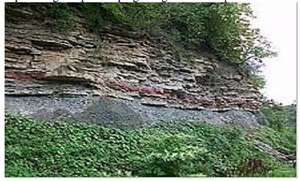
Principal reservoirs are in delta-front sands.[3] These deltaic sandstones form as deltas build out over the deeper-water deposits, and are common in post-organic sedimentary basins from Devonian to Recent for example Clinton sandstone in Ohio (Silurian), Jurassic Brent deltaic sandstones in North Sea. Vertical stacking in deltaic sandstones is common, giving rise to multi- pay zones. This is mainly due to individual delta lobes typically building out over and beside earlier lobes as subsidence proceeds and basin fills. Deltaic sandstones typically have a coarsening upward sequence, with individual sand bodies often elongate, lobate,or parallel to the paleo- shoreline but discontinuous along strike. During diagenesis; deltaic sandstones, although coarser, may often be cemented by early-formed silica and are commonly less productive. The cementation may block migration of hydrocarbons from the deeper sources into beds such as onshore fluvial deposits higher up in the prograding delta-fill sequence.
Shoreline sandstones
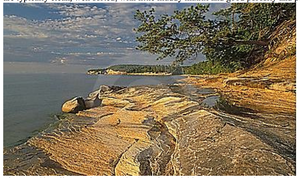
Shoreline sandstones are convex upwards sand deposits with associated marine and lagoonal shales serving as both source rock and as well as seals; these sands are best developed along gently sloping shoreline areas, subject to transgression and/or regression with fluctuations in sea level, basin subsidence or sediment supply, and are mainly deposited in coastal and shallow marine environments, but most significantly are those formed by beaches and offshore (Figure 7); including coastal barriers and those associated with tidal channels. With slow transgression or regression, the individual shoreline sands may progressively overlap to form sand sheets such as transgressive sand sheets which occur on unconformity surfaces as the sea level rises and encroaches on over the land. Shoreline sandstones deposited on beaches are narrow, linear, elongate and oriented parallel to the shoreline while barrier shoreline sandstones are finer grained than the beach deposits, and are more discontinuous laterally. However, both beach and barrier shoreline sands are typically clean, well sorted; with little muddy matrix and good porosity and permeability.
Deep sea sandstones
Deep marine sandstones are formed by processes operating in deep oceanic environment such as gravity flows and turbidity currents, driven by down-slope movement of sediment under gravity, and ocean-bottom currents driven by movement of ocean water in three-dimensional circulation pattern, at depths of >200m and on the contential slope and adjoining abyssal plain, and are often associated with pelagic limestone, which represents carbonate ooze formed by accumulations of planktonic organisms, and are commonly part of a submarine fan deposit. These sub marine fans have a central feeder channel within which sediments move by debris flow from which lesser channels branch out onto the middle part of fan. The sands in lesser channel and the lower parts of the fan is transported by stirred-up suspensions of sediment in water thus forming a sharp erosive base with a fining up grain size sequence of a few centimeters or tens of centimeters thick and a distinctive sedimentary profile. Petroleum which is generated from pelagic beds associated with these sandstones, and channel up-dip towards the main fan feeder channel, can be trapped in the sand beds of deep-water marine sandstones. Examples of deep-sea sandstone reservoirs include Ventura and Los Angeles basins and Frigg field in Eocene of the North Sea.
Glacial sandstones
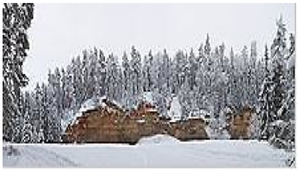
Glacial sandstones are poorly sorted matrix-bouldery sand deposits consisting of sands, lenses left by melt water streams with reservoir potential and other glacial deposits left by retreating glaciers as moraine deposits. Examples of these glacial sandstones include tillites, with little value as a reservoir due to low porosity. Glacial sandstones may also be deposited in marine areas, giving rise to muddy sediments with dispersed boulders. These may however be locally reworked by wave action in shallow area resulting into potential reservoir sand bed for example Ordovician oil- bearing glacial sands found in Algeria and Permo-carboniferous hydrocarbon glacial sands in southern Oman.
Aeolian sandstones
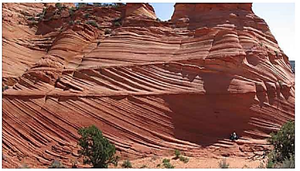
Aeolian sandstones are wind-blown sand dunes of coastal and desert environments. Dunes are heaped-up shaped ridges of sand with crests either parallel to wind direction (longitudinal dunes) and perpendicular to the prevailing wind (transverse dunes) although they may also be crescent- shaped. Dunes advance down- wind direction by erosion of sand from up-wind side and depositing sand on the down-wind (lee side).the up-wind face clearly has a gentle inclination while the down- wind face has a steeper slope. sand added to this steeper slopes runs down this slope adding to it and building cross beds which when buried within the dune forms large scale high-angle cross beds (Figure 9); whose dips are in the same direction as wind direction, thus providing an indication of paleocurrent direction in ancient dune sands. Aeolian sandstones are extremely well sorted because of their wind-blown nature and hence have good porosity and permeability. However, with desert deposits, they are less likely than other types of sand to be associated with organic accumulations that would act as hydrocarbon source rocks and provide a petroleum charge. Aeolian sandstones are commonly associated with evaporites which are salt deposits. They can thus have a complex diagenetic history, which may in some cases block the pores of the sand with chemically precipitating cementing materials.
Sandstone reservoir quality
Sandstone is the best known petroleum reservoir rock with an average porosity of about 15% and permeability of 25-100 Darcies which are mainly depend on the depositional environment, the character of the minerals forming the matrix and diagenesis. Diagenesis significantly reduces the porosity and permeability of sandstone reservoirs as illustrated in the case study below:
A case study of reconstruction of the diagenesis of the fluvial-lacustrine deltaic sandstones and its influence on the reservoir quality evolution[5]
Location of study area
The Yanchang Oil Field is located in the northern Shaanxi slope, the western Ordos Basin in China which inclines gently to the west with a dip angle of less than 10 .Faults are not developed in the area, but some faults occur on a small scale.
Stratigraphy
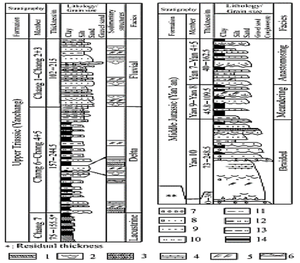
The Yanchang Formation of the Upper Triassic is a suit of terrestrial fluivolacustrine-deltaic sequence, consisting one of the main hydrocarbon-producing intervals in the area. The Upper Triassic Yanchang Formation can be divided into three facies from the bottom to the top (Figure 10).
Evolutional diagenesis
Diagenesis is mainly classified into stages:
- Early diagenesis: Early diagenesis was controlled by the depositional facies and detrital composition. Early diagenesis mainly includes mechanical compaction, early diagenetic carbonate cementation, dissolution of the detrital fragments, and the mechanical infiltration of grain coating smectitic clay, and precipitation of kaolinite. Mechanical compaction reduced porosity and permeability through increased grain packing and the bending and rupturing of mica and plastic deformation of ductile rock fragments and mud intraclasts. Interaction of meteoric water with sandstones resulted in the dissolution of detrital fragments (mainly feldspars) and the precipitation of kaolinite and smectite.
- Late diagenesis: Late diagenetic alterations include chemical compaction, the albitization of plagioclase, dickitization and illitization of kaolinite, illitization and chloritization of smectite and the precipitation of quartz, ankerite and type II calcite cements. In addition to the increase in temperature and pressure, the spatial and temporal distributions of the late diagenetic alterations, and hence of porosity-permeability evolution of the sandstones, were influenced by the early diagenetic modifications and oil emplacement.
- Epidiagenesis: The uplifting of sediments to the depths shallower than 2km promoted the meteoric water invasion (evidenced by the presence of formation-waters with a brackish composition), leading to the dissolution of silicate grains such as feldspars (mainly plagioclase) and precipitation of kaolinite. The extent of plagioclase kaolinitization varies widely even within the same well, being most extensive in the medium- to coarse-grained fluvial sandstones. Compared with the early diagenetic kaolinite, which is most common in the Jurassic sandstones, late-epidiagenetic kaolinite reveals no evidence of dickitization or illitization.
Burial-diagenetic modifications on reservoir quality
The reservoir quality of Jurassic and Triassic fluvial and lacustrine-deltaic sandstones of the Yanchang Oil Field in the Ordos Basin is strongly influenced by the burial history and facies- related diagenetic events. These sandstones contain both primary and secondary porosities which were formed by the dissolution of framework grains (mainly feldspars and igneous rock fragments) and calcite cement.
Effect of compaction on reservoir quality
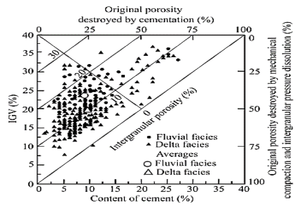
Mechanical compaction during the early diagenetic phase reduced porosity and permeability through increased grain packing, displacement and rearrangement of the detrital fragments, plastic deformation of the ductile mud intraclasts to pseudo matrix as well as bending and squeezing of Biotite between rigid grains. The overall small amounts of early diagenetic cements rendered compaction to be more important than cementation in reducing porosity and permeability ([[:File:Sandstone-Fig-11.png|Figure 11}}).
Effect of cementation on reservoir quality
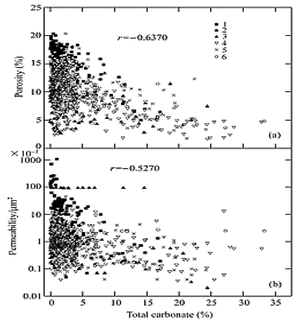
- Carbonate cements are more abundant, and hence have a greater control on porosity and, particularly, permeability of the deltaic sandstones than of the fluvial sandstones.([[File:Sandstone-Fig-12.png|Figure 12}}). A higher overall content of carbonate cement of the delta-front and pro-delta sandstones (av. 4.0% and 4.2%, respectively) accounts partly for the considerably lower reservoir quality. However, the formation of a small amount of early diagenetic quartz cement and homogeneously distributed early diagenetic carbonates in sandstones weakened part of the mechanical compactional effect, and hence the preservation of part of the primary porosity in sandstones.
- The clay minerals have variable influence on reservoir quality evolution. The grain- rimming chlorite and, particularly, illite caused a substantial deterioration of reservoir quality by decreasing the permeability through blocking the pore throats and by increasing the micro porosity.
- The grain-coating chlorite rims and illite around quartz. Nevertheless, chlorite fringes induced the preservation of a considerable proportion of the primary inter/granular macroporosity through inhibiting the precipitation of quartz overgrowths. This resulted in a considerable decrease in permeability, yet often low permeability, in the deltaic sandstones and less commonly in the fluvial sandstones.
- The illitization of intergranular kaolinite(due to the only small degree of albitization of K- feldspar grains), and hence further deterioration of permeability, was inhibited due to the earlier transformation of kaolinite into dickite, which is more resistant to illitization due to its better ordered crystal structure.
Effect of dissolution on reservoir quality
The late diagenesis and epidiagenesis are the main phases for the formation of secondary dissolution pores, which result in the dissolution of detrital plagioclase and calcite cement, and thus enhancement of porosity. The acidic pore-fluids rich in organic and inorganic acids, as well as the meteoric waters, are the main dynamic force and fluid medium for the dissolution of fragments in the sandstones. Plagioclase dissolution was associated with the formation of kaolinite, which typically shows no evidence of dickitization or illitization.
Conclusions
Sandstone is the best known petroleum clastic reservoir rock composed of mainly quartz and/or feldspars, and typically deposited by relatively high-energy processes. Sandstone reservoirs have good porosity and high permeability. However porosity and permeability mainly depend on the depositional environment and burial history diagenesis.
The depositional environments associated with sandstones are very important and they range from terrestrial to deep marine, including: Fluvial; Deltaic ; Aeolian; Shoreline ;Glacial and Deep-sea sediments, including contourite sands formed by ocean-bottom currents, turbidites and submarine fan deposits, formed by gravity-driven mass movements.
The main diagenetic process that affect the sandstone reservoir quality are cementation, dissolution and compaction. Hence good analytical interpretations, research, innovativeness and learnt knowledge of sandstone composition, associated depositional environment and burial diagenetic history are vital for the success of any petroleum industry since over 60% of the world’s giant fields have sandstone reservoirs.
References
- ↑ 1.0 1.1 1.2 Pettijohn F. J., P.E. Potter and R. Siever. (1987). Sand and sandstone. (2nd edition), Springer-Verlag. ISBN 0-387-96350-2.
- ↑ Folk, R.L. (1965). Petrology of sedimentary rocks PDF version. Austin: Hemphill’s Bookstore. 2nd edition. ISBN 0-914696-14-9.
- ↑ 3.0 3.1 3.2 North, F. K., 1985, Reservoir rocks, in F. K. North, Petroleum Geology: Boston, Allen & Unwin, p. 117-218.
- ↑ Reading, H., 1996, Sedimentary environments and facies: Oxford, Blackwell, 704 p.
- ↑ 5.0 5.1 5.2 Luo Jinglan, Morad, S., Zhang Xiaoli, Yan Shike, Wufuli, Li Yuhong and Xue Junmin, 2002, Reconstruction of the Diagenesis of the Fluvial-Lacustrine deltaic Sandstones and its Influence on the Reservoir Quality Evolution. (7th edition), Vol 45. Science in China, pp. 615-634.
- ↑ Li Renwei, Lu Jiacan, Zhang Shukun et al., 1999, Organic carbon isotopic composition in black shales of Sinian and early Cambrian. (6th edition), vol.42, Science in China, pp. 595-603.
Bibliography
- Boggs, S., 1987, Principles of sedimentology and Stratigraphy, Merrill, Columbus, Ohio, 784pp.
- Prothero, D. R. and F. Schwab, 1996, Sedimentary Geology, Freeman, New York, 575pp.
- Selley, R. C., 1985, Ancient Sedimentary Environments and their Subsurface Diagnosis, Chapman and Hall.
- Zimmerie, W., 1995, Petroleum Sedimentology. Kluwer Academic Publishers, Dordrecht.
Acknowledgement
Special thanks go to AAPG association for a great opportunity to write and add value to the geoscience industry and to Assoc. prof. Erasmus Barifaijo, Makerere university for his guidance ,support to the success of this article.
